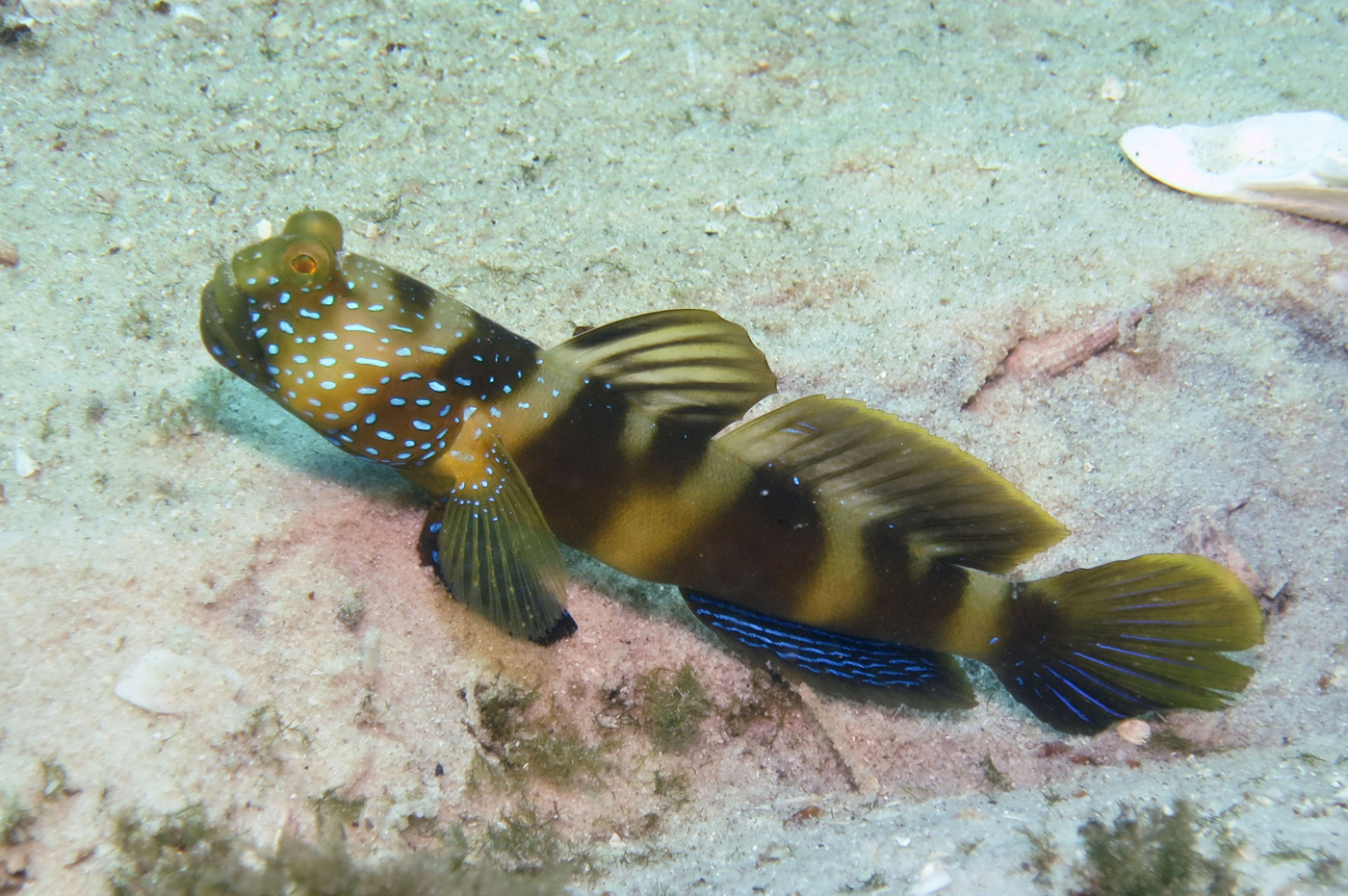Bluelined Shrimpgoby, Cryptocentrus bulbiceps (Whitley 1953)

A Bluelined Shrimpgoby, Cryptocentrus bulbiceps, on sand at Fraser Island, Hervey Bay, Queensland, depth 6m. Source: Sue Churchill & Rogan Draper. License: All rights reserved
Summary:
A pale olive to dusky or brown shrimpgoby with three broad darker irregular bars on the body extending onto the fin bases, a bar on the gill cover extending onto the nape, oblique blue spots or streaks on the head, small blue spots on the pectoral-fin base, bright blue spots covering the pelvic fin, rows of bright blue stripes on the anal fin, and bright blue membranes on the lower half of the caudal fin.
This species is very similar to (and may be conspecific with) Cryptocentrus fasciatus (Hoese 2015).
This species is very similar to (and may be conspecific with) Cryptocentrus fasciatus (Hoese 2015).
Cite this page as:
Bray, D.J. 2017, Cryptocentrus bulbiceps in Fishes of Australia, accessed 27 Jun 2025, https://fishesofaustralia.net.au/Home/species/96
Bluelined Shrimpgoby, Cryptocentrus bulbiceps (Whitley 1953)
More Info
|
Distribution |
Endemic to Queensland, from the Low Isles to Fraser Island. Inhabits inshore sandy/silty areas. |
|
Features |
Holotype: Dorsal fin VI + I, 10; Anal fin I, 9; Pectoral fin 18; Caudal fin 14 branched rays; Scale rows (to hypural) 71; Transverse scales 29. Head (29 mm.) 3.1 in SL, depth (19) 4.8 in SL, breadth of body (12) 7.6 in SL; eye diameter less than snout length. Ocular tentacle absent; maxilla reaching to below eye; teeth in villiform bands on jaws and palate, a few front teeth in upper jaw very slightly enlarged; nostrils small, posterior rounded, near eye; anterior nostril valved, nearer upper lip. Head-pores inconspicuous; head naked except on nape; a few vertical rows of minute papillae arising above upper operculum, one row crossing nape to join the opposite row, other rows in fold on each side of chin; a transverse v-shaped fossa across nape behind eyes. Scales small, cycloid. Third and fourth dorsal spines elongate; pelvic fins united, nearly reaching anus, 10th ray longest; caudal fin rounded, nearly as long as head, with fourteen branched rays, the lowermost short. (From Whitley 1956) |
|
Colour |
A pale olive to pale yellowish-brown or brown shrimpgoby with three broad darker irregular bars on the body (bars sometimes divided on the back and extending onto the fin bases), a bar on the gill cover extending onto the nape, and a dark patch on the rear of the caudal peduncle. Head covered in oblique blue spots or streaks, pectoral fin base and basal part of fin with small blue spots, pelvic fin pale dusky to dark brown and covered in bright blue spots, anal fin dusky to dark brown with about five rows of blue stripes, and lower part of caudal fin with bright bluish membranes. |
|
Similar Species |
Apart from these images, the Bluelined Shrimpgoby is known only from the holotype from Palm Island, Queensland. It is very similar to and may be identical with Cryptocentrus fasciatus (Hoese 2015) |
|
Etymology |
The specific name bulbiceps presumably refers to the bulbous cheeks of this species which were described by Whitley as "bulging". |
|
Species Citation |
Cryptocentroides bulbiceps Whitley 1953, Rec. Aust. Mus. 23(3): 129, fig. 3. Type locality: Palm Islands, North QLD. |
|
Author |
Bray, D.J. 2017 |
|
Resources |
Bluelined Shrimpgoby, Cryptocentrus bulbiceps (Whitley 1953)
References
Hoese, D.F. 2015. Cryptocentrus bulbiceps Australian Faunal Directory. Australian Biological Resources Study, Canberra. Viewed 09 December 2016. https://biodiversity.org.au/afd/taxa/Cryptocentrus_bulbiceps
Hoese, D.F. & Larson, H.K. 2004. Description of a new species of Cryptocentrus (Teleostei: Gobiidae) from northern Australia, with comments on the genus. The Beagle, Records of the Museums and Art Galleries of the Northern Territory 20: 167-174.
Larson, H.K. & Murdy, E.O. 2001. Eleotridae, Gobiidae. pp. 3574-3604 in Carpenter, K.E. & Niem, T.H. (eds) The Living Marine Resources of the Western Central Pacific. FAO Species Identification Guide for Fisheries Purposes. Rome : FAO Vol. 6 pp. 3381-4218.
Whitley, G.P. 1953. Fishes collected by the Australian Museum expedition, 1952. Records of the Australian Museum 23(3): 123-132 figs 1-4 PDF available - open access




